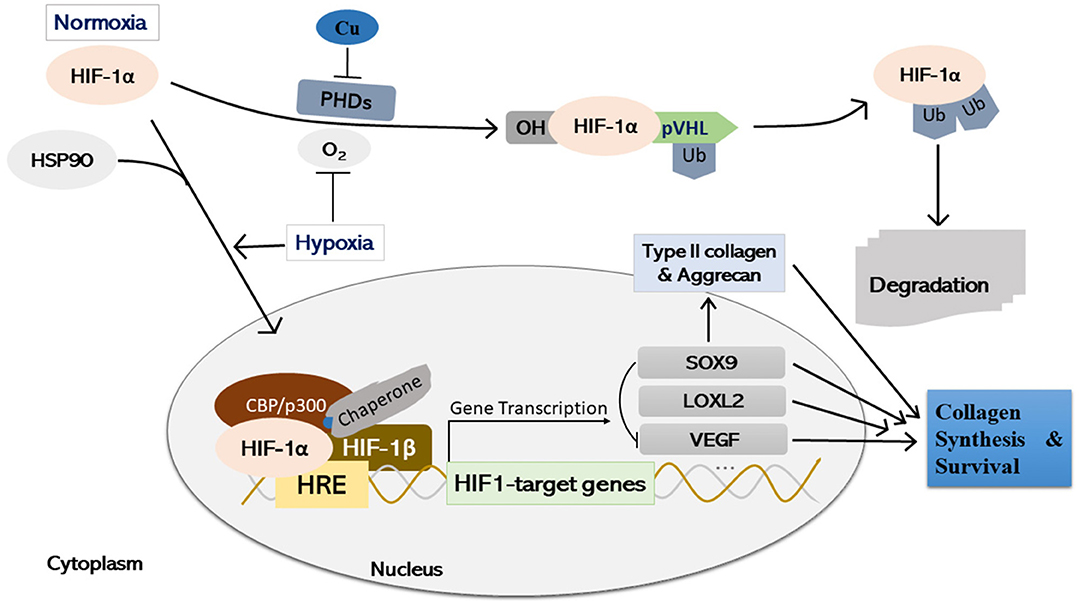
95% of researchers rate our articles as excellent or good
Learn more about the work of our research integrity team to safeguard the quality of each article we publish.
Find out more
CORRECTION article
Front. Bioeng. Biotechnol. , 26 October 2020
Sec. Cell and Gene Therapy
Volume 8 - 2020 | https://doi.org/10.3389/fbioe.2020.598323
This article is part of the Research Topic Cell-Based Approaches for Modulating Cartilage and Bone Phenotype View all 11 articles
This article is a correction to:
Molecular Insights Into Lysyl Oxidases in Cartilage Regeneration and Rejuvenation
A Corrigendum on
Molecular Insights Into Lysyl Oxidases in Cartilage Regeneration and Rejuvenation
by Lin, W., Xu, L., and Li, G. (2020). Front. Bioeng. Biotechnol. 8:359. doi: 10.3389/fbioe.2020.00359
In the original article, there was a mistake in Figure 4 as published. The corrected Figure 4 and figure legend appear below.

Figure 4. Schematic illustration of copper-mediated hypoxia-response element (HRE)-directed transcriptional fine-tuning of cartilage homeostasis-associated genes in chondrocytes. Under normoxia, HIF-1α undergoes PHDs-mediated prolyl hydroxylation, and prolyl OH HIF-1α is ligated by pVHL, an E3 ubiquitin ligase, and degraded by the proteasome finally. Copper stabilizes HIF-1α protein by inhibiting PHDs activity in an iron-independent manner. Under hypoxia or through interaction with HSP90, HIF-1α stabilizes and accumulates in the cell nucleus, where it forms a dimer with the HIF-1β subunit and a putative unidentified copper-chaperone. The dimer then forms a transcriptional complex with coactivator CBP/p300 through binding with HRE, regulating the expression of various downstream target genes, such as LOXL2, SOX9, and VEGF. Simultaneously, SOX9 is a negative regulator of VEGF, whilst the expression of SOX9 target genes (i.e., Type II collagen, and Aggrecan) is initiated, which is essential for cartilage synthesis and survival during both embryonic joint development and cartilage homeostasis. HIF-1α, hypoxia-inducible factor-1α; PHDs, prolyl hydroxylases; OH: enzymatic hydroxylation; pVHL, von Hippel-Lindau tumor suppressor protein; HRE, hypoxia-response element; Ub, ubiquitinated; SOX9, SRY (sex determining region Y)-box 9; HSP90, heat shock protein 90; LOXL2, lysyl oxidase-like 2; VEGF, vascular endothelial growth factor; Cu, copper.
The authors apologize for this error and state that they do not change the scientific conclusions of the article in any way. The original article has been updated.
Keywords: lysyl oxidase, cartilage, hypoxia-inducible factor, copper, transcription activity, regeneration, rejuvenation
Citation: Lin W, Xu L and Li G (2020) Corrigendum: Molecular Insights Into Lysyl Oxidases in Cartilage Regeneration and Rejuvenation. Front. Bioeng. Biotechnol. 8:598323. doi: 10.3389/fbioe.2020.598323
Received: 24 August 2020; Accepted: 25 August 2020;
Published: 26 October 2020.
Approved by:
Frontiers Editorial Office, Frontiers Media SA, SwitzerlandCopyright © 2020 Lin, Xu and Li. This is an open-access article distributed under the terms of the Creative Commons Attribution License (CC BY). The use, distribution or reproduction in other forums is permitted, provided the original author(s) and the copyright owner(s) are credited and that the original publication in this journal is cited, in accordance with accepted academic practice. No use, distribution or reproduction is permitted which does not comply with these terms.
*Correspondence: Gang Li, Z2FuZ2xpQGN1aGsuZWR1Lmhr; Weiping Lin, d2VpcGluZ2xpbkBsaW5rLmN1aGsuZWR1Lmhr
†These authors have contributed equally to this work
Disclaimer: All claims expressed in this article are solely those of the authors and do not necessarily represent those of their affiliated organizations, or those of the publisher, the editors and the reviewers. Any product that may be evaluated in this article or claim that may be made by its manufacturer is not guaranteed or endorsed by the publisher.
Research integrity at Frontiers

Learn more about the work of our research integrity team to safeguard the quality of each article we publish.